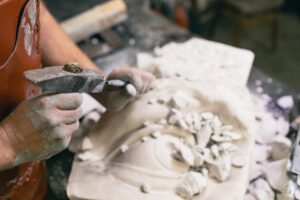
Home » Carve » Tools » Jade & Gemstone Tools » Step One: Select Stone
This is where it all begins, selecting a piece of jade or a gemstone that checks all the boxes. Color, inclusions, dealing with fractures, shape and cost, all to be considered! Each one of these has equal importance but the individual carver will have a bias to one or some of these characteristics. A granite sculptor trying jade for the first time may be attracted to the shapes rather than the color when choosing a stone. A stone with a certain shape that suggests an idea can be an expedient way to begin rather than searching for a piece with certain dimensions and color.
Water should be available when sorting through jade and gemstones. A dry stone will looks gray. At the symposium there should be a basin of water handy on the table to help in sorting through jade and gemstones.


Look for jade that has a clean green, not a muddy green. For different shades of green, some people like a lighter green, some prefer a darker green. Beauty, after all, is in the eye of the beholder. BC jade colors go from black (which is actually a dark green) to a pale or light green. Gem quality jade has been compared to an emerald green color. This is very rare and costly to purchase. Most of the jade offered at the symposia, is a carving grade, with a few really beautiful pieces for jewelry in the mix.
Translucency is achieved when jade is carved to a certain thickness. Dark jade for dangle earrings @ 2 mms thick will result in a deep rich green where lighter jade will almost wash out.
Attractive Inclusions in BC jade are chromite flecks which are a bright green, providing a contrast to the darker green matrix. Pyrite is another one that’s on the plus side. Translucent banding in BC’s Polar jade, aka water marks, have a dynamic appeal. They can be harder than the green matrix, but are well worth the extra effort with finishing. Magnetite is an inclusion to avoid. It appears as black spots, and is commonly seen in lower grades of BC jade. Magnetite is soft, so it tends to undercut in the finishing process.
While spending time at a jade sale , one might see an odd looking star shaped blemish seen on a cut face. Muriatic acid when applied to said blemish, could result in some fizzing action which means these are Calcite inclusions, definitely on the bad list. They dissolve over time, leaving unsightly pits in the jade. The rind of the boulder will show this. Live and learn, I did just that!
Rodingite, a calcium enriched hydrogrossular material, is commonly seen in BC jade as white splashes and veining running through the green. Even with the difficulty to achieve a smooth surface with the hardness differences, the contrasting white to green can be spectacular. It’s a soft inclusion that’s worth the fight!
Fractures will always be an issue no matter what the scale of the project is. The challenge is to eliminate the serious ones that affect the structure of the stone. This can sometimes aid in the designing process. With other jade cultures around the world, there are differing approaches in how surface fracturing is regarded. New Zealand carvers use these “feather fractures” ( ones that do not go deep) to enhance a piece, where in Canada, that’s not always been the case. NZ jade tends to be harder than BC jade which will make a difference in how feather fractures appear.
The shape can suggest an idea which is a more expedient way to begin rather than searching for a piece with certain dimensions. If the latter is desired, it’s best to bring ones own jade for a particular project in mind.
As mentioned BC jade is for sale to the attendees throughout the symposium @ $40.00 lb. Siberian and occasionally Wyoming jade is also available to purchase, those vendors will be the ones to ask for pricing.









We need some kind of descriptive text here.